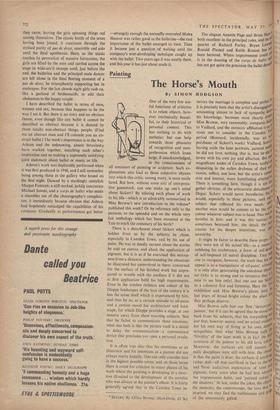Painting
The Horse's Mouth
By SIMON HODGSON
There is a detachment about Sickert which is hidden from us by the subjects he chose, especially in Camden Town. and by his use of paint. He was in deadly earnest about the stories he told on canvas, and about the application of pigment, but it is as if he exercised this serious- ness from a distance, understanding the situations he illustrated but uninvolved in them; concerned for the surface of his finished work but unpre- pared to wrestle with the medium if it did not at first application fulfil his high requirements. Even in the sombre richness and colour of his Dieppe landscapes of the turn of the century it is less the scene itself which is experienced by him, and thus by us, as a certain attitude to oil-paint and a certain mood for architecture and land- scape, for which Dieppe provides a stage, at one remove away from these exacting subjects. Not that he failed to communicate these emotions; what one feels is that the picture itself is a shield to delay the communication—a conventional device that precludes too open a personal revela- tion.
It is often true also that his intentions as an illustrator and his intentions as a painter did not always marry happily. One can only consider him in the highest possible terms, and on those terms there is room for criticism in many phases of his work where the painting is developing in a direc- tion ill-suited to the development of the novelist who was always at the painter's elbow. It is fairly generally agreed that in the Camden Town in- * SICKERT. By Lillian Browse. (Hart-Davis, £3 3s.) period (Bonnard, incidentally, was an C3 it is precisely here that the artist's disengagenle,1 amounting almost to lack of sympathy dc5P',It purchaser of Sickert's work). Vuillard, howch'6i' leaving aside the later portraits, painted not tenors the marriage is complete and perfect.b:, his knowledge, becomes most clearly evici,e; to Vuillard, and the intitniste affiliation is an , vious one to consider in the Camden 1°'0, he did not love, nothing, that is, that he did tr Miss Browse, very reasonably, compares Sick invest with his own joy and affection. But magnificent nudes of Camden Town, lustfulal despairing in the sullen drabness of their st rooms, reflect, not love, but the artist's con' sion and interest, more humiliating alternate`' There is something here, though it is not alt` gether obvious, of the aristocratic detachment Degas; Sickert would never bowdlerise. but v would, especially in these pictures, seek °I e subject that reflected his own needs, 'N1)(00j another man would be content to let the 111 colour whatever subject was to hand. This wast novelist in him; and it was this instinct the fro sometimes betrayed him; the detail, the illt courier for his deeper intentions, v■aS °Pto oth
unworthy.
It might be fairer to describe these props' of • they were not of his actual life—as a means, the subduing his exuberance, a form of self-denla of self-imposed (if naive) discipline. TheY beo .111g one to recognise, however, the truth that his 1.*,k:11 .11g1 appeal is as a manipulator of oil-paint; althou' tes, it is only after penetrating the anecdotal illustr3; the for (who is so strong and so inventive that i .111e easy to see him only), that one can see Sic/ Afl as a colourist first and foremost. Here the Tj the exhibition and Miss Browse's plates deny tit C4! last years of broad bright colour the place the acc they perhaps deserve. fr0 Miss Browse calls him our 'first "democrat' !Ur painter,' but if it can be agreed that he stood 05 in back from his subjects, that his storytelling V131 1.0 just that, however seamy, and no actual eviden't for his own way of living or his own cleerth'e to sympathies, then what Miss Browse calls I are `frivolity' of the later work is in fact the fine tie i. reversion of the painter to his old love, coloLltic jai Moreover, the surfaces are still austere, Shy early disciplines were still with him; the change 111c is that the paint is drier, the surface, if anything; snl rather dull—all was sacrificed in fact to the 1°4 Qf and ?host audacious, exploration of tone and Roy pigment, forty years after he had first adoPte.0 to the impressionist habit, and `painted colour 0. 40 the shadows.' At last, under the jokes, the challhe the memoirs, the controversies, the love that inspired, we may find the ruthlessness and P1'.0
of the enormously gifted.






































 Previous page
Previous page